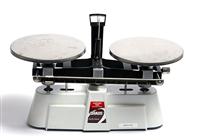One teaspoon of sugar is around five grams.
So it is obvious that one gram is quite a small amount – it’s not difficult to imagine a fifth of a teaspoon and it is not a lot.
But when we are talking about medicines and tests, we often see much smaller quantities mentioned. The standard way of handling these smaller amounts is to keep dividing the units by one thousand.
So if we want units smaller than one gram, the next step smaller would be one thousandth of a gram – which is called a milligram. It gets harder to visualise this – a single crystal of granulated sugar might be a fiftieth of a gram – or twenty milligrams. Standard abbreviation is mg.
The next step is the microgram – which is one thousandth of a milligram. Or you could say it is one millionth of a gram. And any attempt to visualise it starts to fail – but maybe one fifth of the ink required for a single full stop. Standard abbreviation in medicine is mcg (but sometimes you see µg or ug).
When we go beyond medicines and into tests, we need to go much further. And the next step is the nanogram. One billionth of a gram. Standard abbreviation is ng.
Beyond that we have the picogram. One trillionth of a gram. An unimaginably small amount. But something that we deal with all the time. Standard abbreviation is pg.
There are many more steps – but this covers what we usually see when discussing thyroid issues.
In summary, we have:
o... Gram
o... Milligram (1/1000)
o... Microgram (1/1,000,000)
o... Nanogram (1/1,000,000,000)
o... Picogram (1/1,000,000,000,000)
This same system of naming is used not only for weights, but for volume, as in litre, millilitre, nanolitre, picolitre. And mole, millimole, nanomole and picomole (which are effectively counting the number of atoms or molecules).
International Units
Some substances are measured by how much effect they have rather than absolute amount in terms of weight or volume. This is often expressed using the International Unit (IU) - or often simply Unit (U).
Very often, International Units were created before anyone knew what substance was having the effect. And International Units are strictly related to single substances. There is absolutely NO relationship between, say, an IU of vitamin D and an IU of vitamin A.
For vitamin D, one microgram is 40 international units.
But for vitamin A it varies greatly depending on which form of vitamin A you are talking about.
International Units are also used for some blood tests such as TSH concentration are in mIU/L (milli-International Units per litre).
Abbreviations
In medicine there have been deviations from science in how some units are printed. These are usually to try to avoid ambiguity or confusion. Some examples:
A litre is usually abbreviated l (lower-case letter ell), but in medicine we see a lot of L (upper-case letter ell).
The prefix micro- is usually abbreviated µ (Greek letter mu), but in medicine we see a lot of mc or u.
An international Unit is usually abbreviated IU, but in medicine we often see U.
The reason behind this is largely typewriters, computers, and typefaces. It is far too difficult to type characters like µ on typewriters or even computers. And the characters lower-case ell, number one and upper-case letter I are far too easy to mistake for each other. (As in Il1.) And how easy they are to distinguish varies depending on which typeface is used. What might be clear on-screen might not be when printed.
Some typical units
Levothyroxine and liothyronine are measured in micrograms (mcg). (For some bizarre reason, a lot of USA documents use milligrams for these. Which means that you need to use decimal points and leading zeroes. But sometimes they use micrograms. So it is a mess. Be careful on the internet.)
Aspirin and paracetamol tablets are measured in milligrams.
B12 blood tests measure in picomoles per litre or picograms per litre.
Comments
I want to make this blog as understandable as possible. If you think I could improve anything, feel free to send me a message.


 ) something that just won't go in and stay there... 'fraid this is one of them.
) something that just won't go in and stay there... 'fraid this is one of them. 